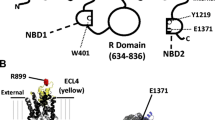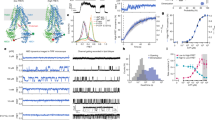Abstract
SITE-SPECIFIC mutation1 and membrane reconstitution2 experiments provide compelling evidence that the product of the gene which is at fault in the disease cystic fibrosis, termed the cystic fibres is transmembrane conductance regulator (CFTR)3, is a small-conductance chloride channel activated by phosphorylation4. As transport of chloride ions is passive, the predicted presence of two nucleotide-binding domains in CFTR seems as puzzling as a report5 that ATP hydrolysis is essential to activate the channel. We now find that in the sweat duct, which expresses high levels of CFTR6 and has a very high Cl− conductance7, intracellular concentrations of ATP must be about normal (5 mM)8 for activation of this conductance, apparently by a non-hydrolytic, perhaps allosteric, mechanism. This passive dependence on ATP should mean that even a modest depletion of cell energy levels will significantly lower the energy demands of electrolyte transport by decreasing chloride conductance. We believe this direct coupling between cellular ATP levels and chloride channel activity is an adaptive mechanism to protect the tissue from damage resulting from excessive energy depletion9.
Similar content being viewed by others
References
Anderson, M. P. et al. Science 253, 202–205 (1991).
Bear, C. E. et al. Cell 68, 809–818 (1992).
Riordan, J. R. et al. Science 245, 1066–1072 (1989).
Tabcharani, J. A., Chang, X. B., Riordan, J. R. & Hanrahan, J. W. Nature 352, 628–631 (1991).
Anderson, M. P. et al. Cell 67, 775–784 (1991).
Kartner, N. et al. Nature Genet. (in the press).
Quinton, P. M. Am. J. Physiol. 251, C649–C652 (1986).
Williamson, J. R. & Corkey, B. E. in Meth. Enzym. 13, 434–513 (1969).
Quinton, P. M. & Reddy, M. M. Adv. exp. Med. 290, 159–172 (1991).
Fussle, R. et al. J. Cell Biol. 91, 83–94 (1981).
Flockhart, D. A., Friest, W., Hoppe, J., Lincoln, T. M. & Corbin, J. D. Eur. J. Biochem. 140, 289–295 (1984).
Hartman, J. et al. J. biol. Chem. 267, 6455–6458 (1992).
Thomas, P. J. Shenbagamurthi, P., Ysern, X. & Pedersen, P. L. Science 251, 555–557 (1991).
Ashcroft, S. J. H. & Ashcroft, F. M. Cell Signal 2, 197–214 (1990).
Atkinson, D. E. Metabolism and its Regulation (Academic, San Francisco, 1977).
Thomas, P. J., Shenbagamurthi, P., Sondek, J., Hullhen, J. M. & Pedersen, P. L. J. biol. Chem. 267, 5727–5730 (1992).
Reinstein, J. et al. Biochemistry 29, 7440–7450 (1990).
Author information
Authors and Affiliations
Rights and permissions
About this article
Cite this article
Quinton, P., Reddy, M. Control of CFTR chloride conductance by ATP levels through non-hydrolytic binding. Nature 360, 79–81 (1992). https://doi.org/10.1038/360079a0
Received:
Accepted:
Issue Date:
DOI: https://doi.org/10.1038/360079a0
- Springer Nature Limited
This article is cited by
-
Innovative Therapies for Cystic Fibrosis: The Road from Treatment to Cure
Molecular Diagnosis & Therapy (2019)
-
Purinergic control of lysenin’s transport and voltage-gating properties
Purinergic Signalling (2016)
-
Allosteric modulation of GABAA receptors by extracellular ATP
Molecular Brain (2014)
-
PKA Mediates Constitutive Activation of CFTR in Human Sweat Duct
Journal of Membrane Biology (2009)
-
Effect of Cytosolic pH on Epithelial Na+ Channel in Normal and Cystic Fibrosis Sweat Ducts
Journal of Membrane Biology (2008)





